Safety should be your top priority if you’re a proud garage owner. One crucial aspect of safety in garage setups is the lighting system. Proper lighting is essential for a safe and efficient environment, whether you use your garage as a workshop, storage space, or parking area.
Garage lighting allows you to see clearly when working on projects or locating tools and plays a vital role in preventing accidents. Insufficient lighting can lead to tripping, falling, or even harming oneself with sharp objects or dangerous machinery.
To ensure safety in your garage lighting setup, it is essential to understand the regulations and compliance standards that govern this area. Compliance with these regulations helps create a safe working environment and ensures you adhere to legal requirements.
Regarding garage lighting, two critical regulatory aspects must be considered: electrical safety and building code compliance. Ensuring proper electrical safety involves using appropriate wiring methods, grounding techniques, and electrical protection devices. Adhering to building codes ensures that your lighting setup meets the necessary structural and safety requirements.
This blog post will delve deeper into the importance of ensuring safety in garage lighting setups, the relevant regulations and compliance standards you need to know, and practical tips to ensure your garage lighting is up to code. Let’s shed some light on creating a safe and well-lit environment in your garage.
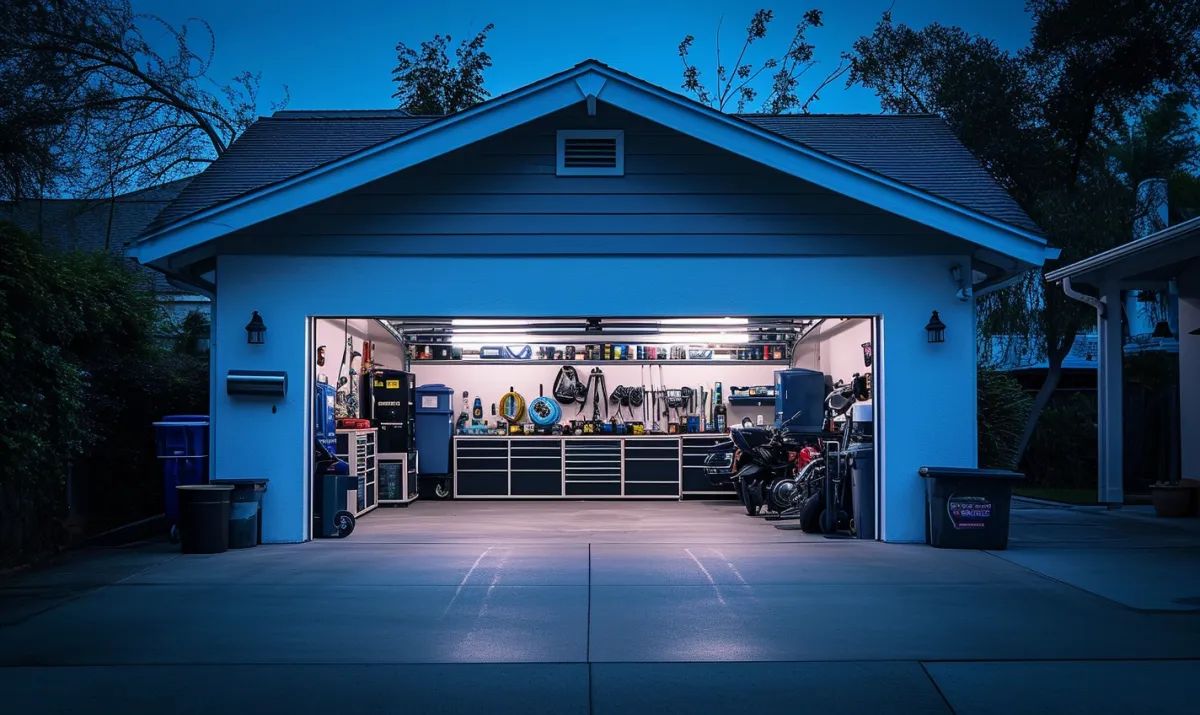
The Importance of Adequate Lighting in Garages
Why is proper lighting crucial for your garage?
When it comes to your garage, ensuring the safety of your workspace is of utmost importance. One key aspect often overlooked is adequate lighting. Effective lighting enhances visibility and helps prevent accidents, improving overall productivity and efficiency.
The dangers of inadequate lighting
Insufficient lighting in your garage can pose several safety hazards. Poor visibility can lead to tripping, slipping, or falling, especially when navigating tools, equipment, or clutter. It may also make identifying potential dangers such as sharp objects or leaks difficult.
Additionally, inadequate lighting can cause eye strain, fatigue, and reduced concentration, increasing the risk of injuries or mistakes while working in the garage. This is especially crucial for using power tools or working with heavy machinery.
The benefits of proper garage lighting
A well-lit garage offers numerous benefits, including:
- Enhanced visibility: Proper lighting ensures clear visibility, allowing you to see obstacles, hazards, and details more efficiently.
- Increased safety: By illuminating your workspace, you can significantly reduce the risk of accidents, falls, or injuries.
- Improved productivity: Good lighting promotes productivity and efficiency, making it easier to complete tasks accurately and quickly.
- Better focus: Adequate lighting minimizes eye strain and fatigue, allowing you to stay focused and alert while working in the garage.
- Enhanced aesthetics: Well-designed lighting can transform your garage into an inviting and attractive space.
What to consider for adequate garage lighting
When designing your garage lighting setup, there are several key factors to consider:
- Choose the correct type of lighting fixtures that comply with safety standards.
- Properly position and install the lights to maximize coverage and minimize shadows.
- Utilize energy-efficient options such as LED lights, which provide better illumination and have a longer lifespan.
- Maintain and inspect your lighting regularly to ensure optimal performance and safety.
By following these considerations, you can create a well-lit and safe working environment in your garage, significantly reducing the chances of accidents or injuries.
Remember, safety should always be a priority when it comes to garage lighting. Investing in adequate and appropriate lighting can protect yourself, your tools, and your workspace while enhancing productivity and efficiency.
Understanding Safety Regulations for Garage Lighting
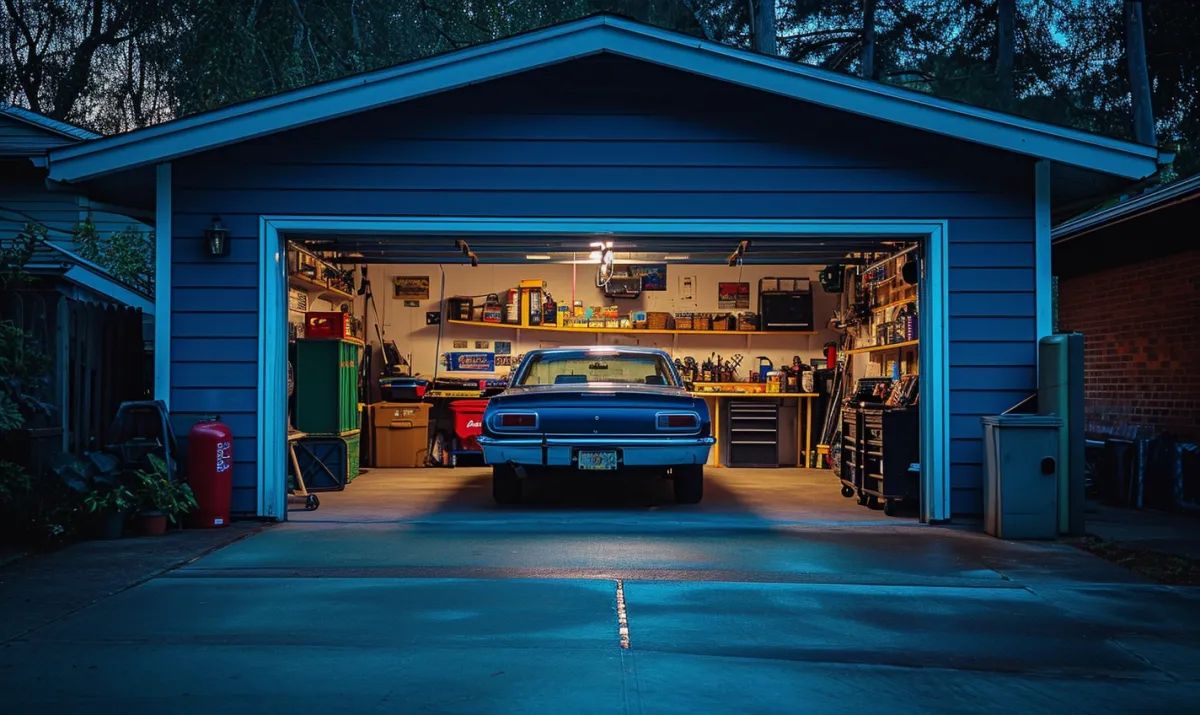
When it comes to setting up your garage lighting, safety should always be a top priority. Understanding safety regulations is crucial to ensuring a well-lit and secure working environment in your garage. Compliance with these regulations protects you and your loved ones from potential hazards and ensures that your lighting setup meets the necessary electrical codes.
Why are safety regulations necessary for garage lighting?
Garages are often used for activities that require good lighting, such as automotive repairs, woodworking, or DIY projects. Inadequate lighting can lead to accidents, eye strain, and decreased productivity. Safety regulations aim to prevent these issues and promote a safe working environment.
Here are some key aspects to consider when it comes to safety regulations for garage lighting:
Adequate Illumination
One of the most critical safety regulations is to ensure your garage is adequately illuminated. Sufficient lighting helps prevent trips, falls, and other accidents. According to the Illuminating Engineering Society (IES), at least 50 candles (FC) are recommended for general lighting in a garage, while task lighting areas require even higher illumination levels.
Fire Safety
Garages often store flammable materials such as gasoline, oil, and paint. Using the appropriate lighting fixtures and ensuring they are adequately spaced from combustible materials is crucial to mitigate the fire risk. LED lights are popular due to their low heat output and reduced fire hazard.
Electrical Codes Compliance
Electrical codes outline installation standards and best practices to prevent electrical shock and fire hazards. Compliance with these codes ensures that your garage lighting setup meets safety requirements. It is recommended to consult a licensed electrician or research the local electrical codes to ensure compliance.
Proper Wiring and Installation
Improper wiring and installation can pose significant safety risks. It is essential to follow manufacturer instructions and seek professional help if needed. Use appropriate wiring methods, secure connections, and adequate grounding for your garage lighting system.
Use of Durable and Impact-Resistant Fixtures
Garages can be high-traffic areas where lighting fixtures are vulnerable to impacts from tools, ladders, or vehicles. Using durable and impact-resistant fixtures helps minimize the risk of shattered glass and exposed wiring, which can lead to injuries and electrical hazards.
By understanding and adhering to safety regulations for garage lighting, you can create a safer working environment and minimize the risk of accidents and injuries. Remember that consulting a professional electrician can provide invaluable assistance in ensuring your garage lighting setup meets the necessary safety standards.
Key Factors to Consider When Designing a Garage Lighting Setup
Designing a safe and effective lighting setup for your garage requires careful consideration of various factors. By addressing these key factors, you can ensure that your garage is well-lit and that the lighting setup complies with safety regulations:
Brightness and Color Temperature
When selecting lighting fixtures for your garage, choosing ones that provide sufficient brightness for the tasks at hand is essential. Consider the color temperature of the lights, as it can impact visibility and comfort. A cooler color temperature, around 4000K, is recommended for garages as it provides bright and clear lighting.
Lighting Layout and Uniformity
Proper lighting layout and uniformity ensure that every garage corner is well-illuminated. Avoid dark spots or excessively bright areas by strategically placing fixtures throughout the space. Aim for uniform lighting coverage to minimize shadows and improve overall visibility.
Energy Efficiency and Cost Savings
Opting for energy-efficient lighting solutions helps reduce your environmental impact and saves on electricity costs. LED lights are an excellent choice for garage lighting setups due to their long lifespan, low energy consumption, and minimal heat emission. Additionally, consider installing motion sensors or timers to turn off lights automatically when not in use.
Durability and Safety
Garages can be harsh environments with exposure to dust, vibrations, and potential impacts. Choose lighting fixtures that are durable and can withstand the conditions of your garage. Look for fixtures with a high Ingress Protection (IP) rating to ensure they are resistant to dust and water. Additionally, ensure that all electrical connections are correctly insulated and fixtures are securely mounted to prevent accidents.
Flexibility and Adaptability
Garage lighting needs can vary depending on the task at hand or changes in workspace requirements. Consider implementing a lighting setup that allows for flexibility and adaptability. This can be achieved using adjustable fixtures, dimmable lights, or additional lighting zones to cater to specific work areas or projects.
When designing your garage lighting setup, you can create a safe and efficient working environment by considering these key factors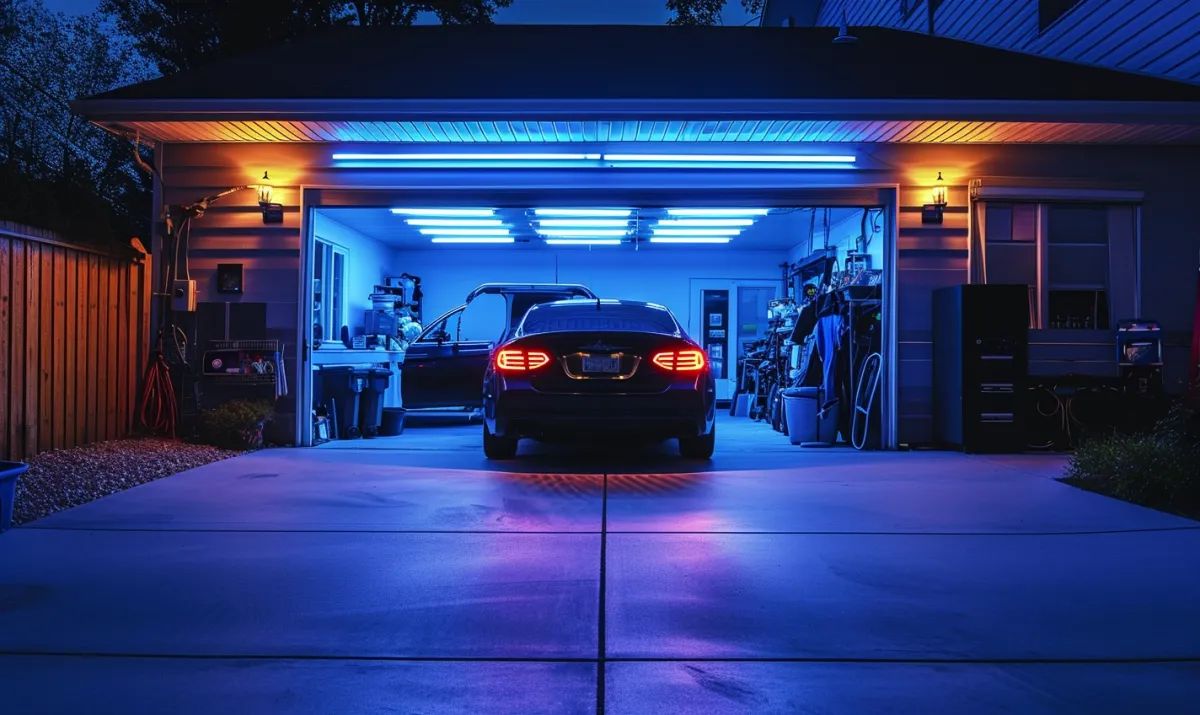 . Be sure to consult local safety regulations and codes to ensure compliance, and always prioritize the well-being of yourself and others in your garage.
. Be sure to consult local safety regulations and codes to ensure compliance, and always prioritize the well-being of yourself and others in your garage.
Types of Garage Lighting Fixtures That Comply with Safety Standards
Regarding garage lighting setups, ensuring safety is of utmost importance. Using lighting fixtures that comply with safety standards reduces the risk of accidents and provides a well-lit and secure working environment. Here are some types of garage lighting fixtures that meet safety regulations:
LED Lights:
LED lights are a popular choice for garage lighting due to their energy efficiency and durability. They produce bright light while consuming less energy, making them an eco-friendly option. LED lights also have a longer lifespan, reducing the need for frequent replacements and maintenance.
Fluorescent Lights:
Fluorescent lights are another widely used option for garage lighting. They provide a consistent and bright illumination, making it easier to work on projects. Additionally, fluorescent lights are available in different sizes and types, including T8 and T12 bulbs, allowing you to choose the best fit for your garage.
Motion-Activated Lights:
Motion-activated lights are a great addition to any garage lighting setup. These lights automatically turn on when motion is detected, ensuring the entire area is well-lit whenever someone enters. This helps improve safety by eliminating dark corners and reducing the risk of accidental falls due to insufficient lighting.
Vapor-Tight Lights:
In garages with moisture or dust, vapor-tight lights are an excellent choice. These lights are designed to withstand harsh conditions like moisture, dirt, and debris. With their sealed housing, vapor-tight lights protect the bulbs and electrical components, prolonging their lifespan and ensuring safe operation.
High Bay Lights:
High bay lights are ideal for garages with high ceilings, such as commercial or industrial spaces. These lights are designed to illuminate large areas from a higher distance, providing consistent and even lighting. High bay lights are also energy-efficient, ensuring cost savings in the long run.
Choosing lighting fixtures in your garage that comply with safety standards is essential. You can create a well-lit and secure environment while minimizing the risk of accidents by using LED, fluorescent, motion-activated, vapor-tight, or high bay lights.
Proper Placement and Installation of Garage Lighting
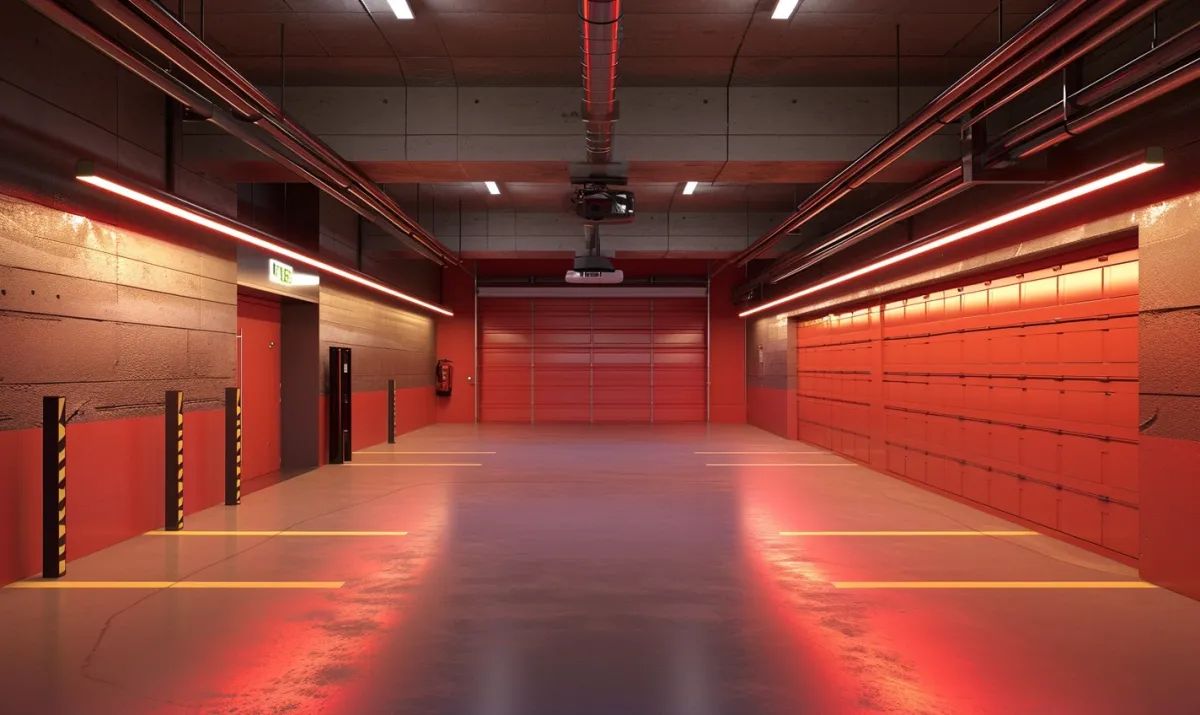
Proper placement and installation are crucial factors to consider when ensuring safety in your garage lighting setup. By following these guidelines and best practices, you can create a well-lit and safe working environment in your garage:
Assess the layout of your garage:
Before installing any lighting fixtures, take some time to evaluate the layout of your garage. Identify the areas where lighting is most needed, such as workbenches, tool storage areas, and entrances/exits. This assessment will help determine the number and type of fixtures required for adequate illumination.
Choose the suitable fixture types:
Selecting the appropriate lighting fixtures for your garage is essential. LED fixtures are highly recommended due to their energy efficiency, long lifespan, and bright output. Look for fixtures with a high color rendering index (CRI) to ensure accurate color representation and visibility.
Install lighting strategically:
Proper installation of lighting fixtures is crucial to avoid shadows, glare, and uneven illumination—place fixtures at equal intervals to maximize coverage and minimize dark spots. Avoid positioning lights directly above reflective surfaces, as this can cause blinding glare.
Consider the height:
The height at which you install your lighting fixtures can significantly impact the overall illumination. Aim for a mounting height that allows for even light distribution while avoiding excessively bright spots that could strain the eyes. Consider using adjustable fixtures to customize the light direction as needed.
Ensure adequate lighting levels:
Garages typically require higher lighting levels than other home areas due to the nature of tasks performed in these spaces. Aim for at least 50-foot candles (FC) of light, with even higher levels around work areas. Use a light meter to measure the lighting levels and make adjustments accordingly.
Don’t forget about exterior lighting:
In addition to interior lighting, it’s essential to provide adequate illumination for the exterior of your garage. This includes pathways, driveways, and entrances. Use outdoor-rated fixtures with motion sensors or timed controls to enhance security and ensure safe navigation during nighttime hours.
Following these guidelines ensures that your garage lighting setup meets safety regulations and provides optimal visibility for all your tasks. Remember, a well-lit garage is essential for completing projects effectively and promotes a safer and more enjoyable workspace.
Benefits of LED Lights for Garage Lighting
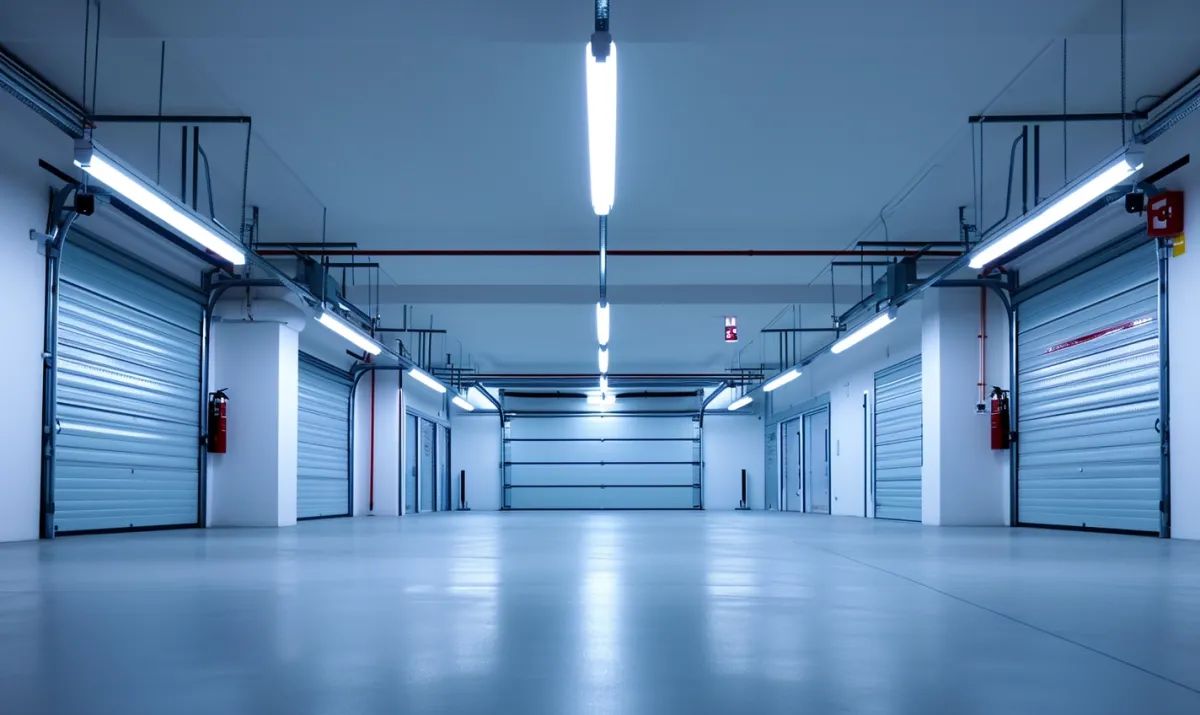 LED lights are the top choice for many homeowners when choosing the proper lighting for your garage. Not only do they provide excellent visibility and energy efficiency, but they also offer a wide range of benefits that can enhance the safety and functionality of your garage. Let’s explore some key advantages of using LED lights for your garage lighting setup.
LED lights are the top choice for many homeowners when choosing the proper lighting for your garage. Not only do they provide excellent visibility and energy efficiency, but they also offer a wide range of benefits that can enhance the safety and functionality of your garage. Let’s explore some key advantages of using LED lights for your garage lighting setup.
Longevity and Durability
LED lights are known for their exceptional lifespan. With an average lifespan of around 50,000 hours, LED lights can last significantly longer than traditional incandescent bulbs. This means less frequent replacement and reduced maintenance costs in the long run. Additionally, LED lights are more resistant to shocks, vibrations, and external impacts, making them highly durable and suitable for garage environments.
Energy Efficiency
LED lights are highly energy-efficient, consuming significantly less energy than traditional lighting options. They convert more electricity into light rather than heat, lowering energy bills. By switching to LED lights, you can save up to 75% on your lighting energy consumption, making them an eco-friendly and cost-effective choice for your garage.
Bright and Uniform Lighting
LED lights produce bright and uniform illumination, ensuring adequate visibility in your garage. This is particularly crucial when working on projects that require attention to detail and precision. LED lights offer a higher color rendering index (CRI) than other lighting options, meaning they can accurately render colors, making distinguishing between different objects in your garage easier.
Instant On/Off
Unlike fluorescent lights that may require warm-up time, LED lights provide instant on/off functionality. This means you don’t have to wait for the lights to reach their full brightness when entering the garage or experience any flickering. With LED lights, you can enjoy immediate illumination and enhanced convenience for your garage space.
Environmentally Friendly
LED lights are free from harmful substances such as mercury and lead, making them environmentally friendly. Choosing LED lights for your garage reduces your carbon footprint and promotes a healthier living environment for yourself and future generations.
In conclusion, LED lights offer numerous benefits for garage lighting setups. With their long lifespan, energy efficiency, bright illumination, and instant on/off functionality, they are an excellent choice to ensure your garage’s safety, efficiency, and productivity. Moreover, LED lights are environmentally friendly and can save you money in the long run. Switching to LED lights is a wise investment to enhance your garage lighting experience significantly.
Ensuring Compliance with Electrical Codes for Garage Lighting
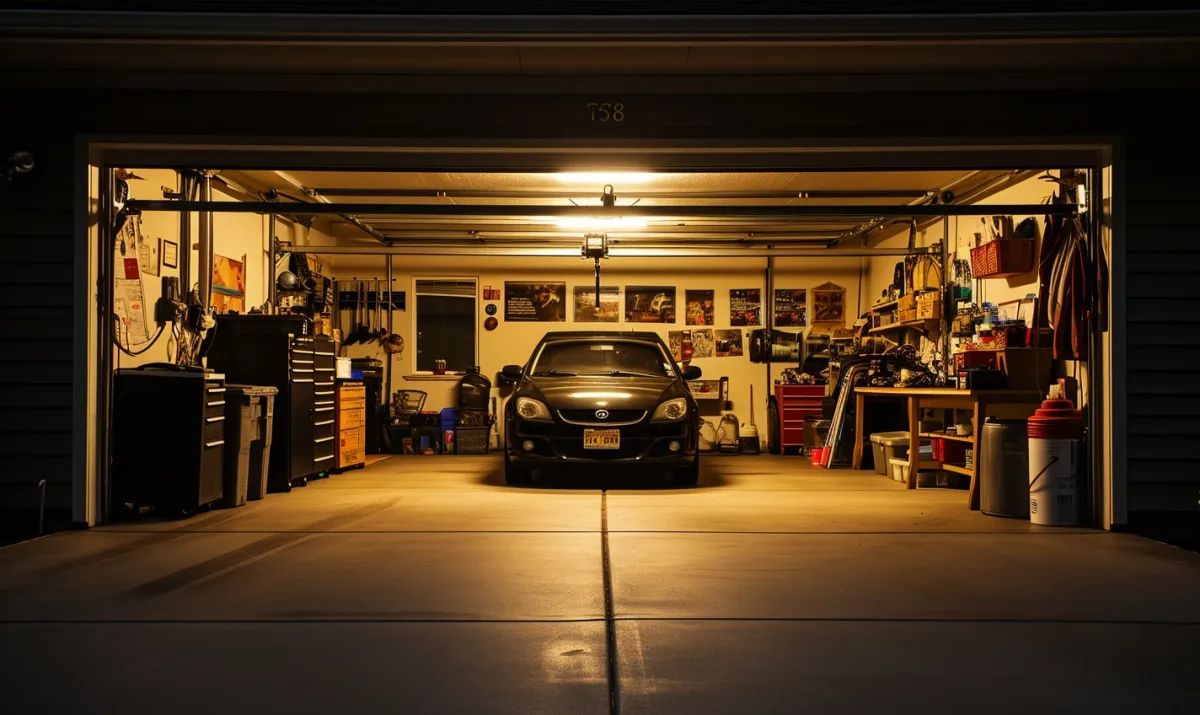
When planning your garage lighting setup, it is crucial to ensure that you comply with all electrical codes and regulations. This not only promotes safety but also prevents potential hazards and legal issues. Here are some essential factors to consider when it comes to compliance:
Understanding Local Codes and Regulations
Electrical codes and regulations may vary from one location to another. Familiarizing yourself with local building codes is essential to ensure your garage lighting setup meets the required standards. This will involve understanding the requirements for wiring, circuit protection, grounding, and fixture installation.
Working with Certified Electricians
Complying with electrical codes is best achieved by working with certified electricians knowledgeable and experienced in installing lighting systems. Professional electricians will ensure that your garage lighting setup adheres to the codes and regulations, providing peace of mind and a safe working environment.
Choosing Approved Lighting Fixtures and Components
When selecting lighting fixtures and components for your garage, choosing those approved by regulatory bodies such as the National Electrical Code (NEC) and Underwriters Laboratories (UL) is essential. These approved products have undergone rigorous testing to meet the required safety standards.
Proper Wiring and Grounding
Proper wiring and grounding practices are crucial for safety and code compliance. This includes using the correct wire gauge, ensuring proper connections, and adequately grounding the electrical system. These practices will prevent electrical accidents, such as fires and shocks.
Proper Placement and Protection
Another critical compliance aspect is ensuring your garage lighting fixtures are properly placed and protected. Fixtures should be located in appropriate areas to provide adequate lighting and minimize shadows. Additionally, they should be protected from physical damage, such as impact or water exposure, to maintain their functionality and prevent accidents.
Maintenance and Regular Inspections
Regular maintenance and inspections ensure your garage lighting setup remains safe and compliant. This includes checking for damaged or faulty fixtures, addressing electrical issues, and ensuring all components are in good working condition. Regular inspections also help identify potential safety concerns and address them promptly.
Adhering to electrical codes and regulations can create a garage lighting setup that prioritizes safety and compliance. Remember, it is always better to invest in the right lighting fixtures and work with professionals who understand electrical codes to avoid any potential risks and ensure a well-lit and safe working environment in your garage.
Maintenance and Inspection Tips for Safe Garage Lighting
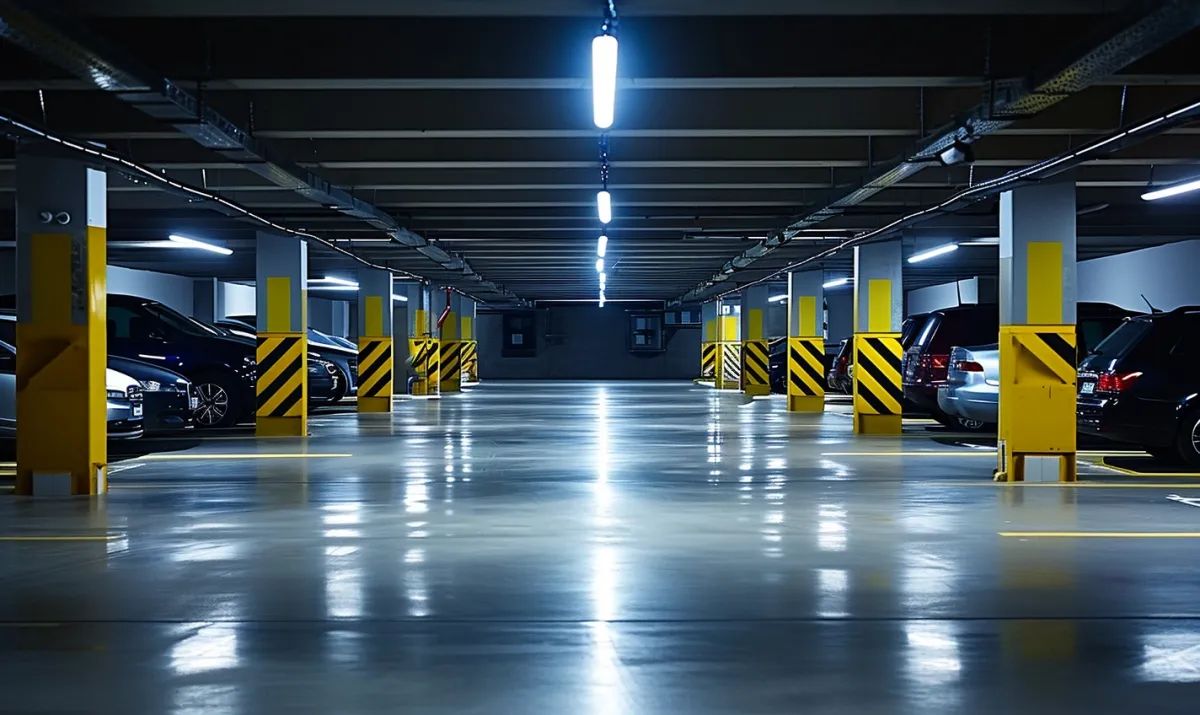
A well-designed and adequately installed garage lighting setup is crucial for ensuring the safety and functionality of your workspace. However, it’s equally important to regularly maintain and inspect your garage lighting to avoid any potential hazards. Here are some maintenance and inspection tips to keep your garage lighting safe:
Regularly clean and dust your lighting fixtures:
Dirt, dust, and debris can accumulate on your lighting fixtures over time, reducing their efficiency and posing a fire hazard. Clean your fixtures regularly using a soft cloth or a vacuum cleaner with a brush attachment to remove any build-up.
Check for loose connections:
Loose connections can lead to electrical sparks and an increased risk of fire. Regularly inspect the wiring connections in your garage lighting system and tighten any loose connections you may find.
Verify the condition of the electrical cords:
Please inspect the condition of the electrical cords and ensure they are free from fraying, cracking, or any signs of damage. Damaged cords should be replaced immediately to prevent electrical hazards.
Test the switch and controls:
Check the functionality of the switches and controls in your garage lighting system. Ensure they are working correctly, and replace faulty components as needed.
Replace burnt-out bulbs promptly:
When you notice a burnt-out bulb in your garage lighting, replace it promptly with a new one of the same wattage and type. Using a different type or wattage can overload the fixture and increase the risk of overheating.
Inspect for signs of moisture or water damage:
Moisture or water can damage your lighting fixtures and create a hazardous situation. Regularly inspect your lights for any signs of moisture or water damage, such as rust or corrosion. If you find any, take immediate action to fix the source of the moisture and replace any damaged fixtures.
Schedule professional inspections:
While you can perform basic maintenance tasks, it’s also essential to schedule regular inspections by a qualified electrician. They can identify hidden issues, ensure compliance with safety standards, and provide professional guidance on maintenance and repairs.
Conclusion:
Maintaining and inspecting your garage lighting is vital to ensuring safety in your workspace. By following these tips and regularly assessing the condition of your lighting setup, you can mitigate potential hazards, prolong the lifespan of your fixtures, and create a well-lit environment that enhances productivity and safety in your garage.
Creating a Well-Lit and Safe Working Environment in Your Garage
When it comes to your garage, ensuring both safety and adequate lighting is crucial. Whether for personal use, DIY projects, or as a professional workspace, a well-lit garage prevents accidents and improves productivity. Here are some critical steps to creating a well-lit and safe working environment in your garage:
Assess Your Lighting Needs
Start by evaluating the size and layout of your garage. Consider the specific tasks you’ll be performing and the lighting level required. For general illumination, overhead lighting fixtures can provide broad coverage, while task lighting can be added for specific work areas that need additional brightness.
Invest in Quality Lighting Fixtures
Choosing light fixtures that comply with safety standards is crucial. LED lights are an excellent choice for garages as they have a longer lifespan, consume less energy, and provide brighter illumination. Look for fixtures with proper insulation and durable materials to withstand the demanding garage environment.
Optimize Lighting Placement
Proper placement of lighting fixtures is essential for the even distribution of light. Ensure that the lights are strategically placed to eliminate shadows and dark spots. Consider installing task lighting near workbenches, under cabinets, or in areas where detailed tasks are performed.
Be Mindful of Electrical Codes
Compliance with electrical codes is critical for safety. Ensure the electrical wiring and connections are done by a licensed professional to meet all the requirements. Follow local regulations for the number of outlets, circuit capacity, and grounding.
Regular Maintenance and Inspection
Keep your lighting setup in optimal condition by conducting regular maintenance and inspections. Replace any damaged or burnt-out bulbs promptly, check for loose connections, and keep the fixtures free from dust and debris. Regular cleaning and maintenance will ensure the longevity and efficiency of your lighting system.
Implement Safety Measures
In addition to proper lighting, consider implementing other safety measures in your garage. Install fire extinguishers, smoke detectors, and emergency lighting. Keep your workspace organized and clutter-free to minimize hazards. Don’t forget to have a clear evacuation plan in case of emergencies.
Following these steps, you can create a well-lit and safe working environment in your garage. Safety should always be a priority when working in any space, and adequate lighting plays a significant role in ensuring a secure and productive workspace.
Addressing Common Safety Concerns in Garage Lighting
When it comes to garage lighting, ensuring maximum safety is of paramount importance. A well-lit garage enhances visibility and productivity and reduces the risk of accidents and injuries. However, several standard safety concerns must be addressed to create a safe working environment in your garage.
Avoiding Glare and Shadows
Glare and shadows can impede your ability to see clearly, increasing the chances of accidents. To avoid this, opt for lighting fixtures with diffusers or frosted lenses that provide a more even light distribution. Additionally, consider positioning your lights to minimize direct sunlight shining into your eyes or creating harsh shadows.
Preventing Overheating and Fire Hazards
Garage lights can generate heat, especially if left on for long periods. To prevent overheating and reduce the risk of fire hazards, choose LED lights as they emit less heat than traditional incandescent or fluorescent bulbs. Check the maximum wattage recommended for your fixtures and never exceed it.
Eliminating Electrical Hazards
Improper electrical wiring and connections in your garage lighting setup can pose significant risks. Ensure that a qualified electrician carries out all electrical work and that the wiring and connections are up to code. Regularly inspect your lighting system for wear, loose wires, or exposed cables, and promptly address any issues.
Securing Light Fixtures
In a high-impact or vibration-prone environment like a garage, it is crucial to ensure that your light fixtures are securely mounted. Loose or improperly installed fixtures can fall and cause injuries or damage. Use appropriate mounting hardware and follow the manufacturer’s instructions to fasten your lighting fixtures securely.
Keeping Lights Clean and Well-Maintained
Dust, dirt, and debris can accumulate on light fixtures over time, reducing efficiency and potentially creating fire hazards. Regularly clean your garage lights, ensuring they are free from obstructions. Additionally, perform routine maintenance checks to identify and fix any issues promptly.
Addressing these common safety concerns in your garage lighting setup can create a safe environment for yourself and others. Remember to follow safety regulations, choose appropriate lighting fixtures, and prioritize regular maintenance to ensure the longevity and effectiveness of your garage lighting system.
Tips for DIY Garage Lighting Projects While Maintaining Safety Standards
Now that you understand the importance of proper lighting in garages and the safety regulations that govern garage lighting setups let’s dive into some practical tips for DIY enthusiasts. These tips will help you create a well-lit and safe working environment in your garage while ensuring compliance with safety standards:
Plan your lighting design:
Before you start installing lights in your garage, take some time to plan your lighting design. Consider factors like the size and layout of your garage, the tasks you will be performing, and the areas that require more focused lighting. This planning stage will help you determine the number and types of lighting fixtures you need.
Choose LED lighting:
LED lights are an excellent choice for garage lighting projects due to their energy efficiency and long lifespan. They produce bright, high-quality light while consuming less electricity. Opt for LED fixtures with a high Color Rendering Index (CRI) to ensure accurate color representation in your workspace.
Install task lighting:
In addition to general overhead lighting, consider incorporating task lighting in areas where you perform specific tasks, such as workbenches or tool stations. Task lights provide focused illumination, reducing eye strain and improving visibility for intricate tasks.
Ensure proper placement:
When installing your lights, place them strategically to eliminate shadows and provide uniform lighting throughout the garage. Avoid placing fixtures too close to flammable materials or other hazards that could pose a safety risk.
Use occupancy sensors:
Installing occupancy sensors in your garage can help save energy and enhance safety. These sensors detect motion, automatically turn on the lights when someone enters the area, and turn them off when the space is unoccupied for a certain period.
Secure wiring and connections:
Properly secure all wiring and connections to prevent accidental damage and electrical hazards. Use cable management systems and secure clips to keep wires organized and out of the way. Ensure all connections are tight and well-insulated to avoid electrical shocks or fires.
Perform regular maintenance:
Maintain your lighting fixtures by cleaning them regularly and checking for any signs of wear or damage. Replace any burnt-out bulbs promptly to maintain optimum brightness. Inspect your electrical system periodically to identify any potential safety issues.
By following these tips, you can confidently embark on your DIY garage lighting project while prioritizing safety and compliance with regulations. Remember, it is always best to consult a licensed electrician if you are unsure about any aspect of the installation process.
Conclusion
In conclusion, ensuring safety in garage lighting setups is crucial for homeowners and professionals. Accidents and hazards can be minimized or eliminated with the proper knowledge and adherence to regulations and compliance standards. Individuals can create a well-lit garage that promotes productivity and enhances safety by following the guidelines set by organizations such as the Occupational Safety and Health Administration (OSHA) and the National Fire Protection Association (NFPA).
Remember to prioritize proper wiring, use appropriate fixtures, and install lighting for each task. Be mindful of the location and placement of lights to prevent glare and avoid creating shadows. Regular inspections and maintenance should also be conducted to ensure all lighting components function effectively and safely.
Investing in energy-efficient lighting options saves money in the long run and reduces the risk of fire and other electrical hazards. LED lighting, for example, is highly recommended due to its longevity, low heat emission, and low power consumption.
You can protect yourself, your loved ones, and your property by staying informed about safety regulations and compliance standards and taking proactive steps toward creating a safe and well-lit garage. Remember, proper lighting improves visibility and contributes to an environment that promotes productivity and enhances overall well-being. So, let’s prioritize safety, follow regulations, and enjoy the benefits of a well-illuminated garage space.
Frequently Asked Questions (FAQs)
Frequently Asked Questions about Ensuring Safety in Garage Lighting Setups
Q: Why is safety important in garage lighting setups?
A: Safety is crucial in garage lighting setups to prevent accidents, minimize the risk of fire hazards, and provide adequate visibility for working and moving around the garage space.
Q: What are the potential safety hazards in garage lighting setups?
A: Some potential safety hazards in garage lighting setups include electrical shocks, short circuits, overheating of fixtures, improper wiring, and exposure to harmful UV rays emitted by specific light sources.
Q: How can I ensure electrical safety in my garage lighting setup?
A: To ensure electrical safety, hiring a qualified electrician to install wiring and light fixtures is essential. Additionally, use proper grounding techniques, ensure the use of appropriate circuit breakers, and avoid overloading the electrical circuits.
Q: Are there any regulations regarding garage lighting setups?
A: Yes, regulations and building codes govern garage lighting setups. These regulations primarily focus on fire safety, electrical safety, and appropriate lighting fixtures suitable for garage environments.
Q: What type of lighting fixtures are suitable for garage environments?
A: Lighting fixtures suitable for garage environments include LED, fluorescent, and vapor-tight fixtures. These fixtures are designed to withstand the harsh conditions typically found in garages, such as temperature fluctuations and exposure to dust and moisture.
Q: How can I choose the proper lighting layout for my garage?
A: To choose the proper lighting layout, consider the size and layout of your garage, the intended use of the space, and the desired illumination level. It is recommended to consult with a lighting professional who can help create an optimal lighting plan for your specific needs.